Editor’s Note 5/19/16: In celebration of National Bike Month in the United States, Sightline is bringing back this cargo-bike classic. Since this article was published in 2012, cargo bikes have gained popularity and are seen all over Cascadia and beyond. Do you own a cargo bike? We want to know what you tow! Email us a photo at editor@sightline.org.
It’s been a hard few months for us fossil-fuel-addicted societies: calamity in the Gulf of Mexico; coal mining disasters in China, West Virginia, and Russia; still-frustrated attempts to win climate and clean-energy policies in Salem, Olympia, and Washington, DC. Perhaps we’re hitting bottom?
If so, catching glimpses of a life cured of addiction can be a step toward recovery. To that end, I’ve been devoting odd moments this year to marveling at some of the innovations going on in human-powered urban transportation: walking carts, community carts, and convertible cart-trailers.
Today: a report from the edges of human-powered conveyance, where pedal pushers are hauling car—and pickup-worthy loads on cargo bikes and trikes. The ingenuity evident across the Northwest and the world in finding practical, nonmotorized solutions to the daily challenges of urban mobility is heartening, even inspiring. It’s also sometimes whimsical and amusing.
Given a price on carbon, policies that grow compact communities, and adequate investment in safe, segregated bikeways, such inventions will proliferate. They’ve already won toeholds in the Northwest’s cities.
Pictured below, for example, are my Seattle neighbors John Floberg and Lisa Hellefond on their weekly grocery run. Their vehicle is their “long tail,” a bike suitable for hauling not only John but also 200 pounds or more of (Lisa and) groceries.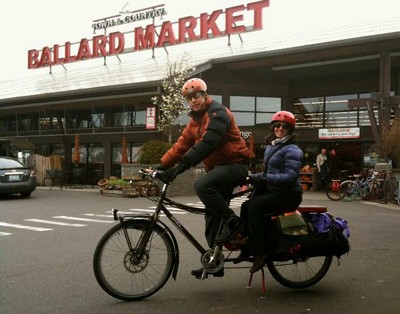
Varieties
Long tails, which put their load in the back on sturdy extended racks, are but one type of cargo bike. (Long tail examples include the Kona Ute, HammerTruck, Yuba Mundo, Work Cycles Fr8, Torker Cargo-T, Batavus Personal Delivery Bike, Surly Big Dummy, and the Xtracycle, which bolts onto a regular bike to make it a long tail. John and Lisa ride an Xtracycle.)
Others, called long johns, put the load in the front. (Examples include the Monark, Velorbis, Bullitt, and Eugene, Oregon-made CETMA pictured below.)
Bakfiets or Box Bikes have built-in cargo cases, usually in the front. (Examples include the Gazelle, Bilenky, Madsen, and two Portland-made bikes: the Metrofiets and the JoeBike pictured below.)
A cargo trike adds not just a crate but also a third wheel. (Examples include Christiania, pictured below, and Velorbis Mobii.)
Uses
Cargo bikes of all these types are spreading in the Northwest, and especially in Portland. No one has been counting, so it’s impossible to quantify the trend yet. But my anecdotal observations make me think that cargo bikes are growing at least as fast as electric bikes—a trend I discussed earlier this year.
What interests me most is not the numbers, which remain small enough to be a marginal phenomenon in Northwest transportation. It’s the variety of uses to which people are putting freight-hauling bikes. They’re becoming human-powered pick-ups. Consider:
My friend (and Sightline trustee) Jeff Youngstrom, a gifted photographer, lives car-free in the town of Issaquah, Washington. He uses his longtail for dozens of hauling purposes (many of them documented here). For example, he used it to carry with him all the supplies he needed to set up a photography exhibit at a community art walk.
The Portland brewer Hopworks commissioned Portland’s Metrofiets to build it a custom “pub bike” (pictured below). BikePortland.org described it as, “A locally built cargo bike that holds two kegs below an inlaid wood bar. A rear rack is built to hold a stack of pizzas; below that a wood-paneled pannier is in fact a compact sound system.”
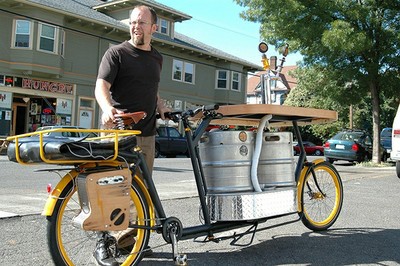
Hopworksfiets – beer and pizza cargo bike, Portland—Flickr photographer Elly Blue, Creative Commons.
Also in Portland, a small company called B-Line PDX recently started offering delivery services on its cargo bikes (pictured below).
Another Portland-powered cargo bike is the portable library called Street Books that serves people who live outside.
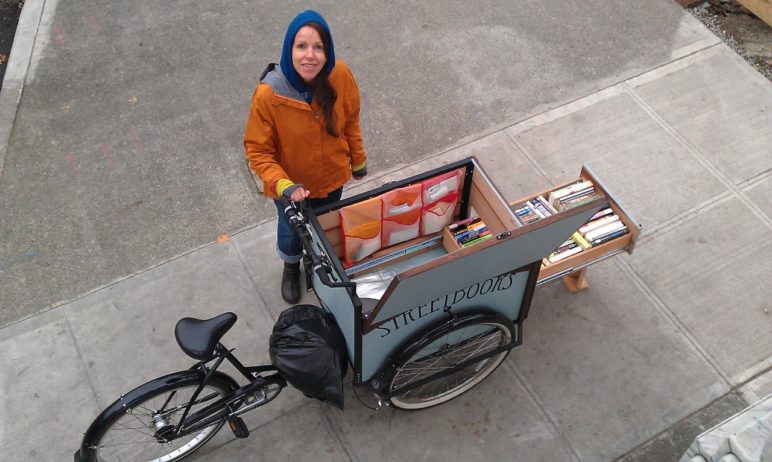
Street Books by Diana Rempe (Used with permission)
Of course, pedal-powered delivery is nothing new in North America. Bike messengers are a common, if dwindling, breed, but pedal-powered freight delivery is rare. It’s less rare abroad. In Paris, for example, private package carrier DHL delivers by cargo trike, as does a company called TNT elsewhere in Europe. In fact, national postal services in both Denmark and the United Kingdom include bike delivery. Urban planner Alyse Nelson (who helped research this post) photographed this official Danish postal bike (along with an impressive variety of other cargo bikes in Denmark (Flickr set here).
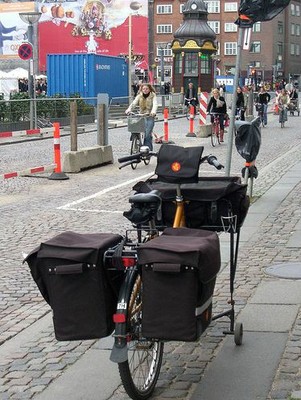
Postal service cargo bicycle in Denmark: courtesy of Alyse Nelson
She also shot this picture of a Danish postal cargo trike.
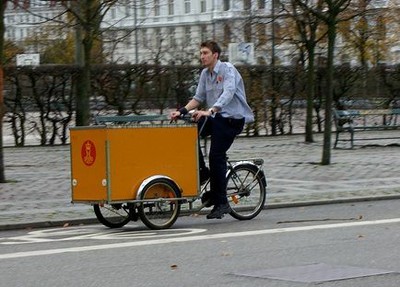
Danish postal service tricycle: courtesy of Alyse Nelson
Speaking of delivery, pizzas are starting to travel on bikes. In my neighborhood of Ballard, in Seattle, Snoose Junction sends its pies out on two wheels. Zaw Artisan Pizza does the same from two Seattle locations. In Oregon, so do at least some locations of Old Town Pizza, Hot Lips Pizza, and Pizza Schmizza. I imagine other Portland shops do, too.
(Readers: please fill us in! The time may soon come when it’s impossible to list all the pizza places in the Northwest that deliver by bicycle, but that day has not yet arrived. So help me update this list. Vancouver? Victoria? Eugene? Spokane? Corvallis? Bellingham? Boise? Which pizzerias offer non-petroleum-based pie transport?)
The national submarine sandwich chain Jimmy John’s delivers by bike from at least some of its Northwest stores. (Don’t be surprised that a chain store would do so. In China, even Dominoes Pizza delivers by bike!) And then there’s SoupCycle—a subscription soup, bread, and salad bike delivery company in Portland that supports local farmers. In Port Townsend, Washington, the Recyclery delivers purchased goods from the farmers’ market to people’s homes, and Bob’s Bagels delivers by bike all over town.
Urban homesteader Patrick Barber of Portland is a pioneer in cargo biking and in-town agriculture. (He’s also a gifted photographer. Check out this set of trike photos. And these.) He and his partner Holly use their cargo trike “like a minivan. We don’t own a car, so we use the trike to carry our daughter, and all her/our associated stuff, to most places that we go in the city. To the farmers market, the grocery store, the park, grandma’s house . . . the library, the garden store, doctors’ appointments.” They even use the trike to pick up and transport out-of-town visitors, such as Patrick’s mom.
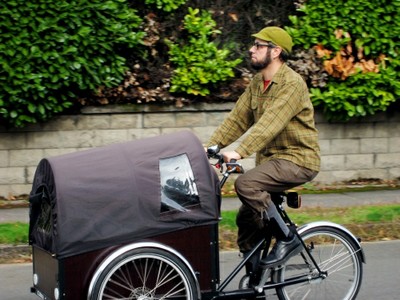
Patrick Barber operating a Christiania trike in Portland, Oregon: ©2007 HollyMcGuire.
Q19, a home cleaning business in Portland, uses box bikes to haul their cleaning supplies around the city.
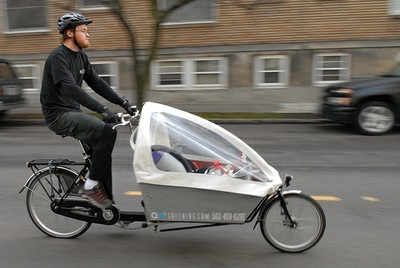
Q19 – cleaning service by bike: Flickr user BikePortland.org, Creative Commons.
Creative Ferment
Cargo biking seems to bring out the adventuresome side of urban dwellers—a point best made through pictures rather words. For example, some freight bikers like the challenge of carrying challenging and oversized loads, like a gardening enthusiast riding a Portland-made JoeBike long john:
And this door hanger riding a Yuba Mundo:
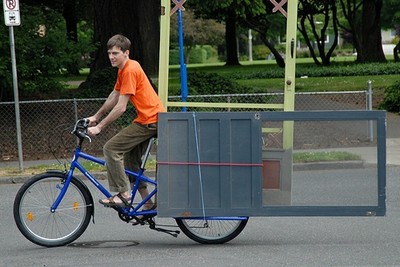
Door hanger on a Yuba Mundo: flickr user BikePortland.org, Creative Commons.
And this teamster on a Bullitt long john:
And the person moving this lumber and corrugated cardboard on a Eugene-made CETMA long john:
And this apartment mover on a Yuba Mundo long tail:
And this man moving boxes on his Truck Trike:
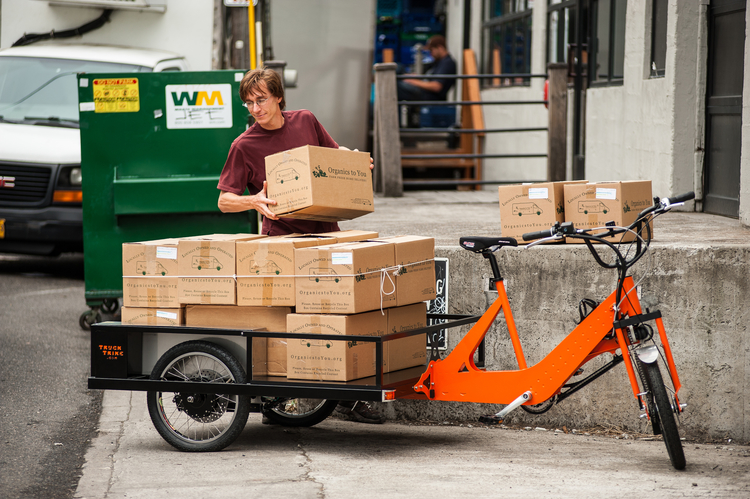
Loading Boxes by Truck Trike (Used with permission.)
And this mover:
Meanwhile (not pictured), there’s this gentleman who pulls a sailboat on a trailer.
For others, these vehicles are more like passenger trains than freights, whether the passengers are in back . . .
. . . or in front.
This Fr8 Family model is designed to carry up to three children in their own seats.
But cargo bikes aren’t just for transporting kids. Here’s an adult musical duo performing while riding in a cargo trike.
(If you like these photos, many more are here, here, here, and here.)
Whimsy
Cargo bikes can also express an artistic streak which, while it won’t end oil addiction or stop climate change, does add a dash of whimsy to urban life (and some frivolity to this post).
Take, for example, the “cart-bike”—a derelict bike welded to a grocery store shopping cart: “It is quite the head turner,” says its originator, “but not a good corner turner.” (Short video here.)
The picnic-table bike is an instant classic, with its built-in grill and sun shade.
A charcoal grill attachment is also possible on a long tail, however, as this Xtracycle video explains.
DIT: EcoDeck – Bar-Be-Que Grill Install from Xtracycle on Vimeo.
Finally, in the absurdist humor category, there is the Waffle Bike, my favorite art bike project. It’s “a fully weaponized waffle making device complete with call to prayer public address system.”
(More novelty cargo bikes, including pedal-powered espresso carts and muscle-driven camper vans, are here. Check them out!)
Picking Up
To pick up my more-serious thread (oops—that reminds me of this fun video of three cargo bikers literally towing a broken pickup), what’s clear from all the inventing and tinkering and experimenting in cargo bikes is that we’ve yet to reach the limits of muscle-powered urban transportation.
I doubt that cargo bikes will ever amount to a substantial share of freight hauling even in cities. The motor is an amazing technology, and hauling large loads is where it makes most sense.
The glimpse beyond carbon addiction is perhaps the greatest public service cargo bikes perform.
Still, cargo bikes seem destined to fill a small but growing niche in our communities. Unlike electric bikes, they fit perfectly into North America’s existing bike culture (macho, anti-auto, lighthearted). They extend options for car-less and car-lite businesses and families. And they make a tremendous amount of sense for certain applications, such as mail and pizza delivery, grocery runs, and in-town service businesses like house cleaners.
As our neighborhoods grow more compact, mixed, and bike-friendly, and when we put a price on carbon, cargo bikes are likely to grow steadily in numbers and uses. They are likely, in fact, to become commonplace—symbols and reminders of how human power and human ingenuity are chipping away at an unreliable, climate-changing, and ocean-endangering petroleum supply.
That glimpse beyond addiction is perhaps the greatest public service they perform.
Like what you're reading? Find out how you can tow your tot on a cargo bike here.
Huge thanks to volunteer and urban planner Alyse Nelson for doing research that made this post possible.

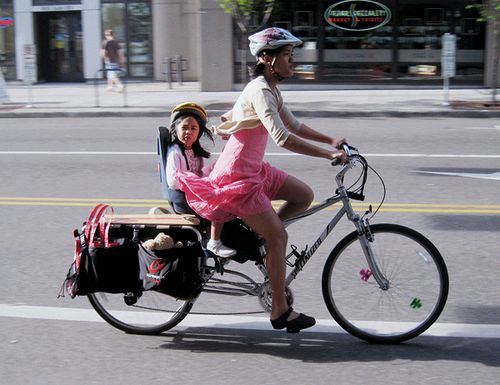

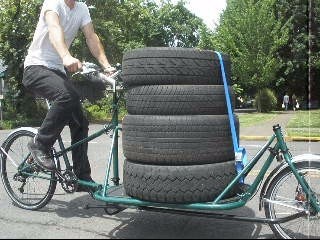
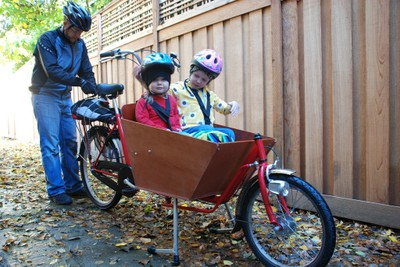
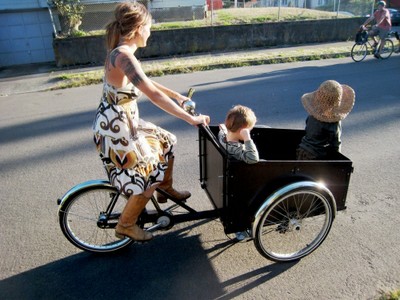
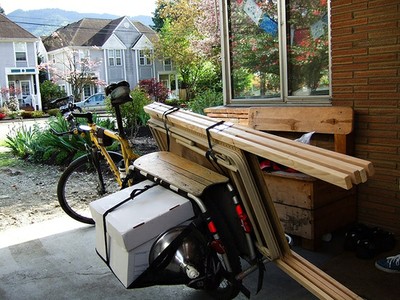
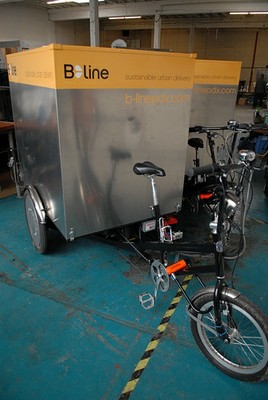
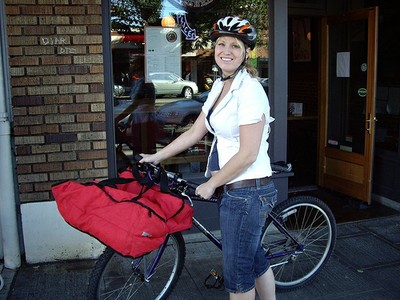
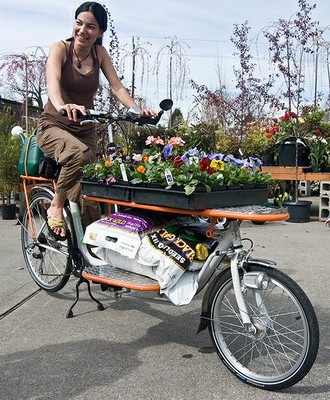
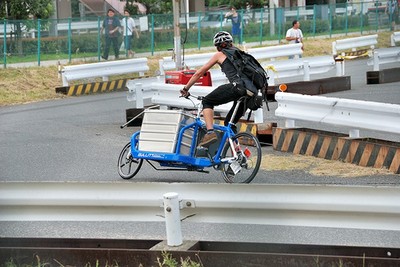
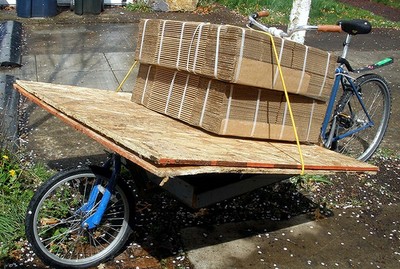
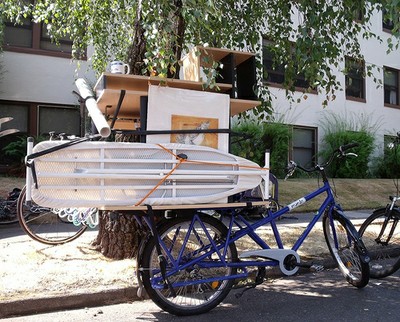
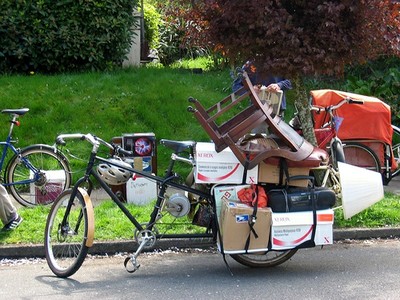
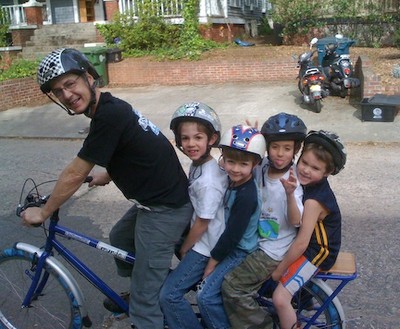
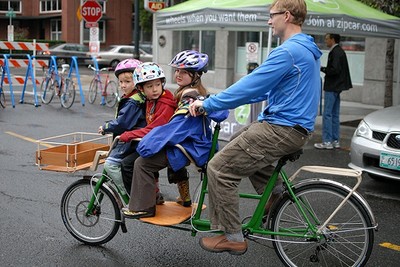
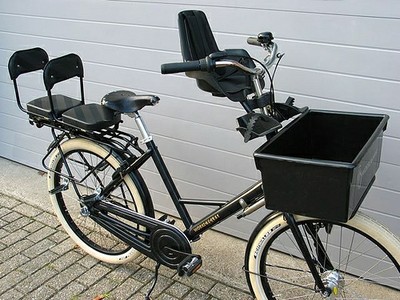
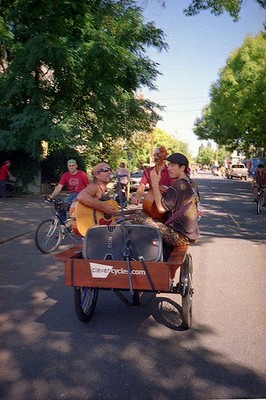
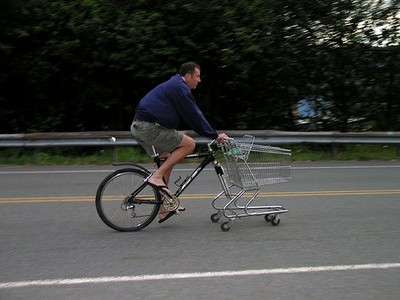








Nicole Bernard
Alan, I love this post. I wonder how these cargo bikes do on the hills and bridges of Seattle and would love to hear more from folks who use them all the time. I’m so impressed with what people manage to trek- they are really maximizing the potential! A reaction and story from my friend in San Francisco: Nice! I love it. The bike coalition loans bike trailers here, and this weekend I saw a guy riding a bike whose front half was a piano. He would stop and play a tune, then ride on.
Matt the Engineer
Don’t forget Pedicabs!Just today I attended a meeting a mile from downtown, and of around 10 attendees only 2 had driven (in a hybrid). The rest had walked or biked. Of course, the sun helps…
MicheLynne
Human-powered bikes are quickly becoming one of the greatest “peace symbols” of the 21st century.
Elisa Murray
Here’s a question I got when I posted the link on Facebook: I love this in concept, but none of the pictures show going UP HILL—esp. in the front of the bike. I have a weeride seat for Miles (which I love) but his 40 pounds definitely make some smaller hills feel bigger. Any feedback on these bikes and hilly neighborhoods (asked the resident of Madison Valley!)?
Alan Durning
Elisa,A good question, and one I can’t answer, since I don’t use a cargo bike (yet) myself. One reason Portland may be more cargo-bike-ful than other NW cities is that it’s got big, flat sections.Some cargo bikers have electric-power assist on their rides. In fact, if you closely study the photos above, you can make out Stoke Monkeys on a couple of the rigs.
Lee Colleton
Carrying heavy loads up Seattle’s hills deserves an electric assist! Frankentrikes are hybrid human-electric engines of the post-fossil future. Currently they’re built by hand here in Seattle by someone looking for investors (and employees).
Michael Ayers
Wow, what an excellent post. I always knew that there were a bunch of cool cargo bikes rolling around the US, but to see so many on one page is really great.If any one is interested, my site has a page with pics of similar bikes in other parts of the world.http://www.terminalia.org/tour/articles/article12.htmCheers,Mike
Alan Durning
There are more interesting comments on the repost of this item, over on Grist: http://www.grist.org/article/cargo-bikes
Tom Ardans
Your Seattle neighbors, John Floberg and Lisa Hellefond, shown in the second photo, actually have an electric assist motor on their bike. It’s a Stokemonkey from Clevercycles.com. Their design, which send the power through the front sprocket, is far better than hub motors efficiency-wise.Sorry, not pitching for them, I just think they’re cool. I am considering hacking my five year old ebike to a front crank drive.
Kathryn Maly
Alan, I LOVE all of the photos you posted along with the info. Wow, what an inspiration.
patrick
Regarding using cargo bikes in hilly places: I use a cargo trike to carry me and my daughter and lots of stuff around Portland. We have one major hill on the eastside, which I climb on a regular basis (we live on it). I have the trike geared very low (19 gear inches—same as a very low “granny gear” on a triple crank) for climbing this hill, and since we don’t go very fast on the bike, the top gear is pretty low, too. This works out just fine, if you don’t mind pedalling very very slowly up a hill. (The advantage to the slow-speed stability of a trike really shines when you are crawling up a hill.) I lived in Seattle for 10 years and used a (normal) bike as my main vehicle while living there. People all over the place complain about cycling up hills, but as far as I am concerned, Seattlites are the only ones who really have anything to complain about. No matter where you go in Seattle, you’re either ascending or descending a hill, and a lot of times, the side-road options, for a quieter or gentler climb, have been carefully planned out of existence. The hills in Portland and in the San Francisco Bay Area (where I’ve also lived) are largely avoidable or manageable, unless you live (or work) at the top of one. But Seattle… that’s tough. If I lived in Seattle again I’d probably restrict my daily cargo-trike usage to a small area (say, Ballard flats) or use an electric assist like the Stokemonkey (which I’d rather not, though Seattle seems like one of the best reasons to go electric). This is one of the reasons we chose to live in Portland rather than Seattle. An Xtracycle with a modicum of cargo/passenger would be a fine vehicle for Seattle, hills and all. If they’d existed back when I lived there, I would have found one very useful. I used to carry musical gear back and forth to play concerts on a regular bike with overloaded panniers; and the one thing I couldn’t quite manage was a big grocery shop, which the Xtracycle can do without flinching. Full disclosure: I took a bunch of these pictures and I am in one of them too (on the cargo trike!).
Nancy
These are great. For more creative ideas on how to use a bicycle/tricyle, look to China. Check out the “What We Could Sell if we Owned a Tricycle” posts on the This Ridiculous World blog. http://thisridiculousworld.com/china/what-we-could-sell-if-only-we-owned-a-tricycle-idea-3-13122008/
Barbara
Thanks for this wonderful post and catalogue of inspiring bikes! It reminded me that in 1960 when my family lived in The Hague, the baker delivered from a bike with a box in front with his wares.
Celt M. Schira
Alan, good essay. I just loved the three cargo bikes hauling a pickup truck. That said, I found the “fully weaponized, call to prayer waffle maker chicken cage bike” in poor taste. The artistic tension between caged chickens and waffle making, got that. The artistic tension between the call to prayer and fully weaponized (two shotguns and a machete, hardly street legal) is a needless jibe at Islam. I’m not a Moslem, and I get it, and it’s not cute and sophisticated. I’ve actually seen street vendors with bike mounted waffle makers in other places (where the health department doesn’t make them drag around a water tank), so it’s not even that much of a gag.
WayUpNorthInAlaska
In Alaska, sometimes a cargo bike needs dog power to go with the human legs that drive the bike. This cargo bike featured two dogs pulling on each side during the Sitka Community Bike Ride in August 2007.http://www.flickr.com/photos/wayupnorthinalaska/2299449286/in/pool-sitkacyclingshowcase
Brynnen Ford
To the question about Seattle hills with cargo bikes, I am a mother of two who lives in the Central Area of Seattle. I have both an xtracycle and a Madsen. On my Madsen I have an electric assist. Sometimes I opt for no assist (when I’m only taking two kids—my older son can hop off and walk/run up the super super steep hills) and other times I opt for the assist (when I’m taking 3 or 4 kids or when I have to get somewhere faster, like to school on time!:)).I’d be glad to let people try my bikes out if you’re closeby…Brynnen
Rachelle Mee-Chapman
Thanks for all the Seattle-specific info! After 3years of biking in Copenhagen (we recognized a lot of the locations and bikes in the photos) we are going to forego buying a car when we return to our house in Wallingford, Seattle. We won’t get a cargo bike, as daily grocery shopping doesn’t require big saddlebags (unlike weekly trips); and the kids are old enough to bike on their own now. Christiania bikes are heavy, and built for super-flat Copenhagen. I can see how an assist would be important in Seattle, esp when fully loaded. Even for my regular bike, I have been thinking of getting an electric assist for the hills. These comments really helped. Our current bikes have Amsterdam style lock built in, where a bar slides thru the rear wheel spokes and locks. Any opinions on if this will be secure enough for an electric assist bike in Seattle environs?
Richard Guy Briggs
This looks like a good place to add the “organ trailer”. It was originally built to haul a half-tonne 1956 Hammond C3 organ load in the 2003 St. Patrick’s Day parade in Ottawa, Canada, but has had many missions since, including many parade floats, moving house, moving multiple fridges, stoves, washers, dryers at the same time, even including the “mobile office”.As far as hills are concerned, it has been used to haul 3/4 tonne up the hill in front of the Chateau Laurier towards Parliament Hill in Ottawa without electric assist. The towing vehicle is a tandem trike with a low gear of 12 to 15 gear inches.http://hpv.tricolour.net/organ-trailer.htmlP.S. I loved the picnic table bike!
Alan Durning
Daniel W. emailed this link, for the art-bike category, concerning the CouchBike.
bama
Great article . . here in Boulder, Colorado (home of the Picnic-Table Bicycle, bar-b-que bikes, and other random creations), I do deliveries for Jimmy John’s via bike. We don’t currently (June 2010) have any pizza deliveries going via bikes, but hopefully in the future.There has been a huge push to deliver Medicinal Marijuana by bikes, but nothing has materialized yet.
VeloBusDriver
Regarding cargo bikes & hills: There are two Seattle bike shops I have visited recently with Surly Big Dummy cargo bikes built up and ready for a test ride: Working Dog Bicycles, near the I-90 trail just off of Rainier Ave (http://workingdogbicycles.com/) and Counterbalance bicycles near University Village (http://counterbalancebicycles.com/).I enjoyed riding the Big Dummy and while the price is a bit steep, it seems like an excellent design. If you are on the edge of getting rid of a car and a cargo bike would help you make that jump, I’m sure the price tag would be easily rationalized.
Ibike
Thanks for a fun article. Just a FYI: The so called “teamster” on the blue Bullit is actually the world champion of cargo bike racing ‘Beaver’ aka. Angus Edmond. The picture is from the World Championships in Tokyo 2009.
coops
hi
Although very late to this article, I have a Bullitt cargobike and use it almost everyday for my work in Sydney (Australia). I’m a carpenter and carry loads as heavy as 100kg (220lbs?) up hills & grades without electric assist.
If you are thinking of a cargobike as a normal bike, then it maybe misleading. The frame geometry of a Bullitt for example keeps the pay-load low and once you have momentum the bike handles extremely well. If fact my Bullitt corners faster and better with 20-30kg on than when empty. The internal hub gearing and hydraulic brakes and steering also is designed with loads, hill & speed in mind.
People & other cyclist are so surprised when I pass them going up hill with several kg on the deck. The Bullitt is the performance SUV of bikes, Its changed the way I live my life and has made financial sense.
Llewellyn Lafford
Here is yours truly astride a pretty sharp 5-speed hauler, used to deliver 3-course meals from a fancy SoHo restaurant in NYC. Almost makes me wish I was a struggling waiter again.
eldestofvic
As impressive as most of these bikes are I cannot emphasize enough…KEEP THE KIDDIES IN A TRAILER. It’s a long way down to the ground for a kid in seat behind (or in front) of an adult if the bike puts its handlebars where the wheels should be!!!
Patrick McMahon
For folks to whom the prices for these bikes (generally between $1,000 and $3,000) are prohibitively high, there are DIY and lower cost options. Tom LaBonty from Portland has been building bakfiet style cargo bikes out of scavenged parts and selling them for almost half the cost of the cheapest new bikes and also has rough instructions on how to build your own. I’m still struggling with whether to buy a used Yuba Mundo, buy a sleigh model from Tom, or try to build one with help from someone else, but there are cheaper options. Also, some other cool options include:http://francescycles.com/galleries/cargo/#2269719181 – Bakfiet with fabric “box” built over metal framehttp://www.trekbikes.com/us/en/bikes/gary_fisher_collection/urban_utility/transport/ – Gary Fisher & Trek’s entry into the long-bike arenahttp://www.kidztandem.com/tandems.htm – Cross between a tandem & a Long John style cargo bikehttp://www.ahearnecycles.com/cycletruck/ – Bike designed with a strong integrated front rack (and smaller front wheel)http://www.treehugger.com/files/2010/05/jacobsgreens-combination-bike-rack-fork-is-zaftig.php – Integrated fork & rack for just $200 (the cheap version of the Ahearne Cycle Truck for your bike)
Michael
You should include a photo of the Zigo Leader Carrier Bicycle as well. Here is a story about an avid Zigo Riderhttp://blog.myzigo.com/2009/11/16/zigo-rider-of-the-month-kaori/
Larry Clarkberg
Alan I have been thinking a lot about your statement that “Unlike electric bikes, [cargo bikes] fit perfectly into North America’s existing bike culture (macho, anti-auto, lighthearted).” I too sense a certain disconnect between the “granola eating” cargo bikers and the “motorcyclist wannabe” ebikers. Why is that? And how can we mend this rift? I think we’ll need to mend this rift before we see a popular clean human-scale vehicle that meets the needs of most Americans. Come together people! I have a bit of an identity crisis myself: I ride a stoked Big Dummy electric cargo bike. In Ithaca an ebike is a no brainer. It doesn’t seem mathematically possible but you can ride in any direction and it will be uphill.
Alan Durning
Michael,I wrote about and linked to the Zigo in my post Transformers—an early entry in this series on human-powered urban hauling: http://www.sightline.org/daily_score/archive/2010/04/26/transformersLarry Clarkberg,I couldn’t agree more!
RosannaCANTU
Yeah by far very considerate for the people it was pleasant to read about this good topic! If you need to get a great job firstofall you need resume writing services. Study and don’t forget – if you have to work and study at the same time, there areprofessionals who are ready to guidance you with your resume when you under time encumbrance and looking for a great job.
Ron
We recently aquired a Zigo for my non-bike riding wife and she has taken to it. It sits upright and one can get on and off the bike quickly without tipping due to the tricycle nature. There isn’t much of a turning radius but she goes slow and isn’t darting in and out of traffic so no big deal. I ride it on the street with my 1 yo in the carrier while my 4 yo rides his bike on the sidewalk. I can help him on and off curbs, and he stops at corners while I check for cars. This is a very handy bike.
BikeBike
Pretty good synopsis of the options available these days. One thing I’d like to point out is the sterotype that cargobike riders are all “granola” and e-bike riders are all “wannabe motorcyclists” – hardly based in reality here in Calgary. Most of the cargobikes we sell go to young professionals, not “granolas” and there is no single sterotype of e-bike rider either. Also, most of the families that bought cargobikes from us did so for the family fun and utility of the bikes – generally, they could give a rats ass about carbon emmisions.Cargobikes are not instruments of political action – they just make sense to some people, in some cities. Here is another perspective on who cargobike riders are and why they buy them – http://www2.macleans.ca/2010/08/23/a-bicycle-built-for-three-plus-groceries/#more-143121In future, please try to keep the sterotyping to a minimum. We’re all riding bikes for one reason or another.
bryan
Big Bike carrying a big bike
http://www.youtube.com/watch?v=tMOPjXF5pWM
Michael
I love this as a bike resource. I found a lot of cool bikes that I otherwise would not have known about. However, I of course must object that you have not mentioned my favorite, the Zigo Leader Carrier Bike.
Alan Durning
It’s in this post: http://www.sightline.org/2010/04/26/transformers/
Jenn Dederich
Great article. Love to see our friends in the industry here. Our company uses long tail bikes with our custom product signage enclosure, Pyxis to provide concierge delivery and advertising services in Portland,Oregon. We are so lucky to be in the hottest spot for cargo bike innovation in the US, maybe even the world. Check us out at http://vimeo.com/search?q=portland+pedal+power
ask
Thank you for the good writeup. It actually was a enjoyment account it.
Glance advanced to far introduced agreeable from you! However, how could we keep up a correspondence?
Dave
Being a cheapskate, I found that a bodged up kiddie trailer makes a great cargo hauler. It fits a load of groceries, including a malt beverage or two, with no trouble at all.
Dan Meek
Package delivery companies (UPS, FedEx, others) should be using cargo trikes, instead of trucks, to deliver within downtown areas. This would reduce traffic congestion, parking problems, and emission of global warming gases. Larger cargo trikes could use electric assist. UPS and FedEx are using cargo trikes for this purpose in Europe but not in USA.